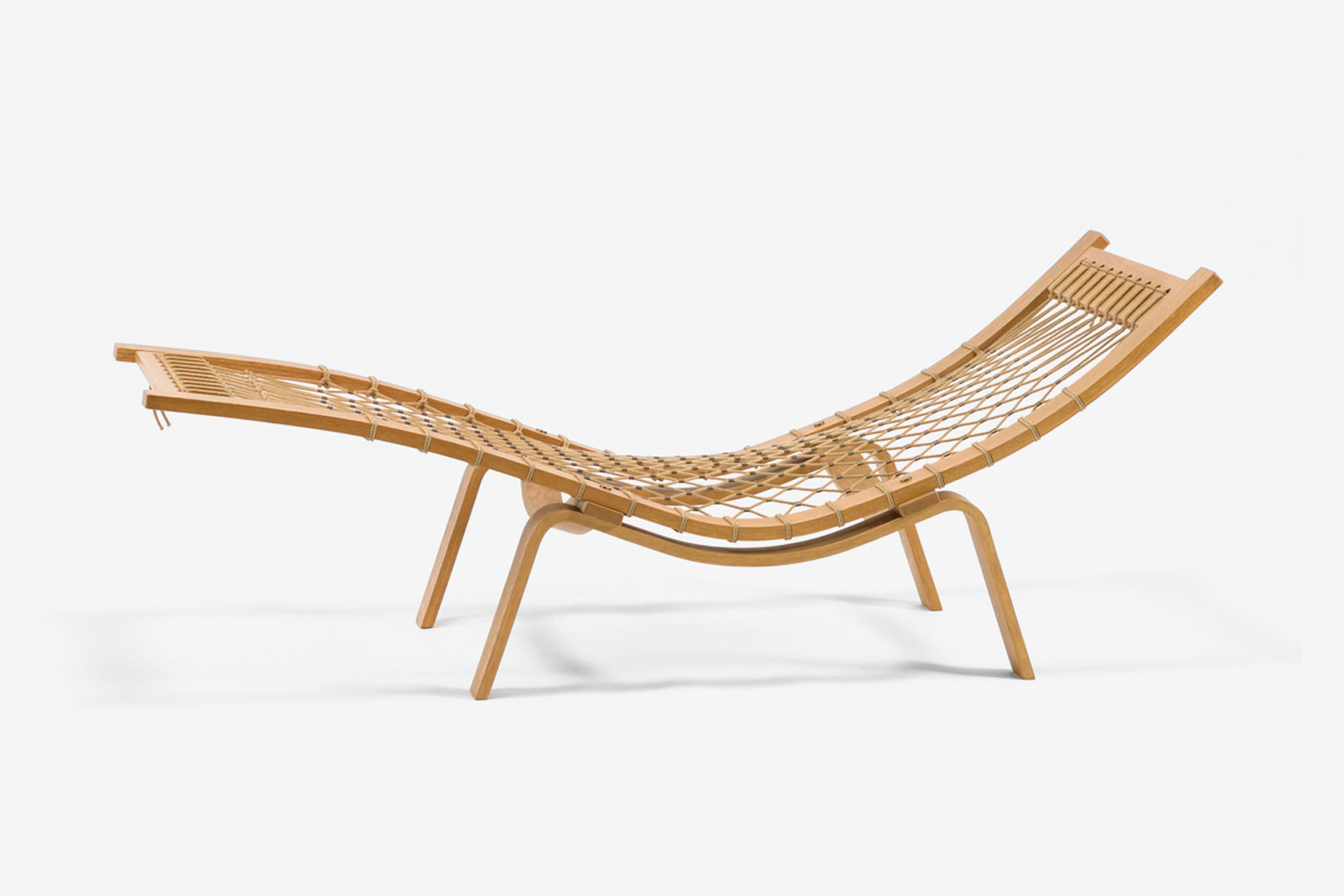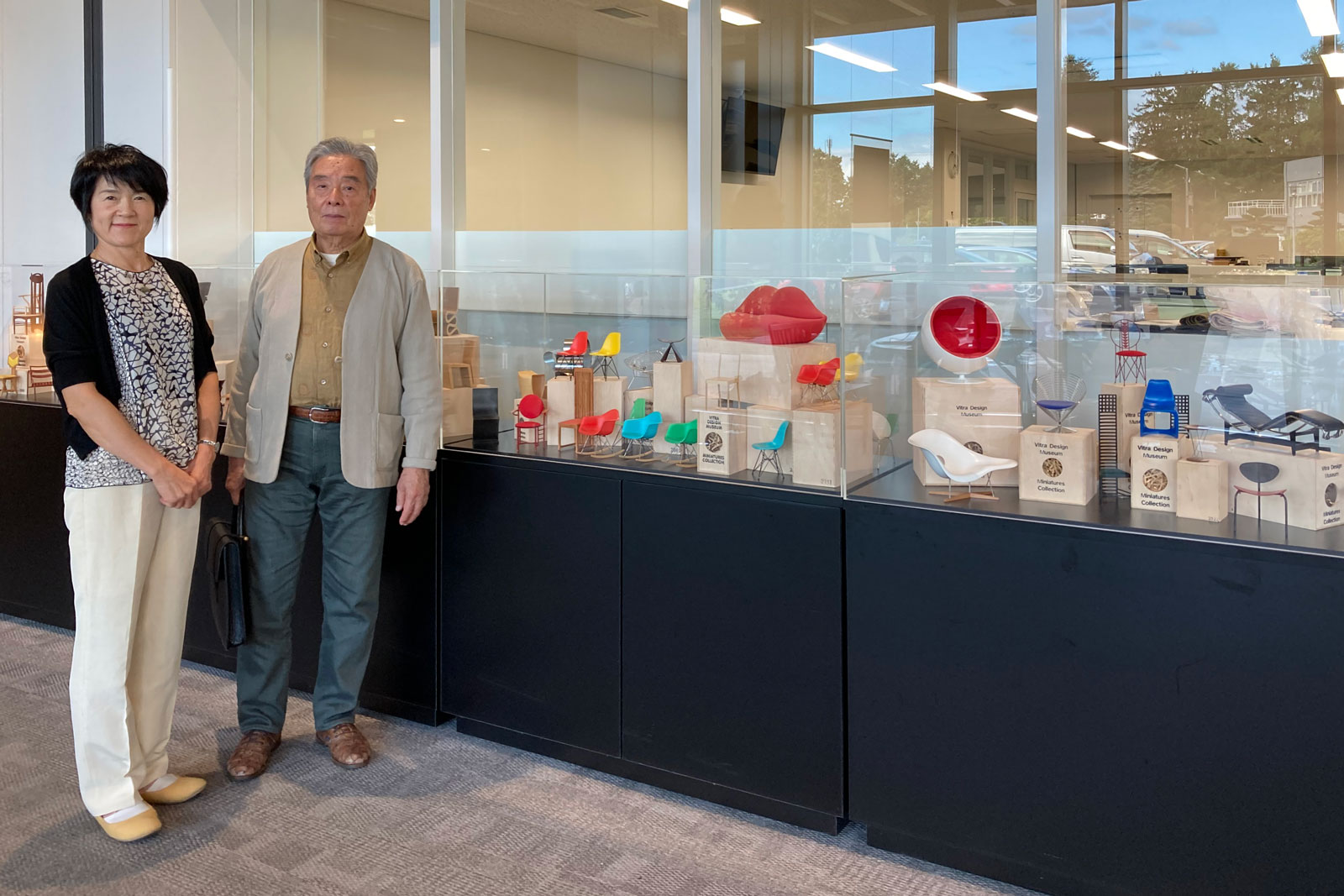
Hammock chair, 1967
It is one of the seven chaise longues announced by Wegner, and as its name suggests, it has a structure that holds the body with a net-like rope. Like the “Hoop Chair” introduced in Episode 2, the rope is woven with metal clips that do not form knots, making it very comfortable to sleep on. At the time, the wood was made of oak, but now PP Møbler uses ash.
While actively collecting chairs, this is a piece that
I thought I absolutely had to keep.
In 1980s, the number of chairs increased rapidly, and I think there were about 20 to 30 chairs by Wegner’s works alone. Since Wegner did not design many chaise longues, I had decided to have all seven types, but the one I had a hard time finding was the Hammock chair. The molded plywood frame has a beautiful curve, and the holes on the sides are recessed to allow the net to drop under your weight. Like all Wegner chairs, this one hits the sweet spot the moment you lie down. Among them, the Hammock chair is a very comfortable chair, and I remember that it was used in the Wegner House by the window in the living room facing the terrace, with a piece of sheep’s fur on it. The other day, I purchased a “Bear Chair” at the request of my family. It features sturdy elbows that allow you to hang it in any way you want, such as sitting sideways or diagonally, and it fits snugly into your body in any position. Even families who normally use cushions and headrests to find the comfort that best suits them are using this chair as is saying “It’s better without anything.”
I really wanted it,
but I couldn’t get it no matter what.
This was when I co-managed a design office in Osaka with a friend and worked day and night to pay for the chairs. I visited Getama in Denmark, which was manufacturing Hammock chairs at the time, and asked them if I could buy one for my research. I saw that there were four hammock chairs in parts in the back of the warehouse, but at that time, the company president was the top employee, and he turned me down saying, “I don’t have the authority to make decisions.” When I saw the real thing in front of me, I couldn’t get it, so I returned home disappointed. Still, I couldn’t give up, so I kept sending letters for a year, but they still wouldn’t sell me. After a while, the hammock chair was put up for sale by Arne Brunn Rasmussen, a major auction house known for selling many masterpieces. This time I thought for sure, I participated in the bidding, but the price went up in the blink of an eye, making it far beyond my reach, and I couldn’t win the bid.
It spread throughout Denmark that
“There is a Japanese man who is reevaluating our country’s chairs.”
The hammock chair came to me in an unexpected way four or five years later, and it probably all started with the World Design Expo held by Nagoya City as part of its 100th anniversary commemoration project. Among them, the “180 Danish Chairs Exhibition” was held using my collection. During the five-day exhibition period, the number of visitors far exceeded expectations, with some sitting on the floor and intently looking behind the chairs, others bringing their own lunches and staying all day from opening to closing and some people visited the museum for 3 days in a row. There was even a high school where a teacher led an entire class to see the exhibition, and its popularity made it big news in Denmark.
POLITIKEN, a national newspaper similar to Japan’s Asahi Shimbun, published an article about the chair exhibition in a 30-page spread. A total of 14 to 15 media outlets, including local newspapers, covered the story. There is no doubt that these reports helped make my name and my efforts known to the Danish general public. The Japanese man is reevaluating our own furniture culture, which even the Danish had abandoned at the time. This became a hot topic, and a traveling exhibition called, “Finn Juhl Memorial Exhibition” was subsequently held in the first floor lobby of POLITIKEN. As I’ve said many times before, keep holding on to your dreams without wavering and spare no effort. Someone is definitely watching it.
Call came from the Danish Embassy in Tokyo,
“A fax has arrived from Denmark addressed to Mr. Oda.”
Four or five years after the aforementioned auction, I received a phone call from Mr. Shinji Araya from the Danish Embassy (who I later met again as an employee of Louis Poulsen). I received a fax from an elderly couple in Danmark asking me to purchase a chair for them. I was surprised to see the paper that was forwarded to me, and it said, “I would like to give away my hammock chair.” “I’ve used it with care, so I’d rather have Mr. Oda in Japan buy it than sell it at auction for a high price to a stranger.” The asking price was also written there. Since it was an amount that I could pay immediately, I told the embassy to let them know I would send the money immediately. In this way, I was finally able to add my long-awaited hammock chair to my collection. You can see from this series that I Have had many such good fortunes in my research career. I am grateful that the activities that I have continued to do steadily have permeated the world in various ways, such as the report by Politiken that I mentioned earlier.
Luck comes when you are pushed into a corner (laughs).
There was a surprise at this year’s Scandinavian exhibition.
“Scandinavian Design Exhibition” was held at Takashimaya, Osaka in August 2023. On the same floor as the event hall, there were several vintage shops selling Scandinavian items. Among them was “Lystig” which I mentioned in this series. Pre-exhibition preparations continued until late at night, and when I took a quick peek during a break, I saw a dove-shaped bowl from the Royal Copenhagen “Tenera” series that I had been looking for. I went to Lystig the next day as soon as it opened, and asked the owner, who I have known for 25 years, to reserve the bowl and the rimmed mirror. Tenera is a popular series developed by six female designers in their 20s, led by Nils Thorsson, and is characterized by elegant blue painting. Oda Collection also has about 50 items, including candle stands.
The surprise happened at another vintage shop. At that store, I found a rare chair designed by Mr. Wegner when he was just starting out, which I don’t even own, and a piece from the late 1960s. The owner has also known me for 30 years, and I immediately asked him to reserve it for me. I added the following words: “Academic price please” laughs. The owner replied, “I am fully aware of this.”
After the exhibition ended, I received an estimate by fax to my home. When I looked at it, I saw that the price of the chair was “? Yen”. My guess is that it should cost between 700,000 and 800,000 yen for two legs. I believe that the owner, who understands my past research activities and knows that I have no intention of reselling, supported me despite that hardship I had endured.
August 30th, 2023 Centpure (Higashikawa)
Interviewer: Kano Nishikawa
[ After the interview ]
Mr. Oda moved to Hokkaido alone in 1994 on March 28th, when there was still snow on the ground, and he lived in an apartment in the center of Asahikawa City. I have also been invited to tea with my husband and attended a design tea party with Tokai University professors. There was even one lucky episode in the move. Mr. Oda set up a 4-ton long truck from Osaka and headed to Asahikawa, but there was so much baggage that there was a backlog, so he arranged for an additional 10-ton truck. After arriving in Asahikawa, he realized that the shipping fee was more than double that of a 4-ton truck. Mr. Oda, who was at a loss, unpacked the package and began arranging the materials by author. Then, an envelope pops out between the documents…(It’s like a drama) there were several 10,000 yen bills inside. With that money, he was able to pay for the 10-ton truck, and the move was completed safely. Mr. Oda, the god who shows up when he is in trouble, please lend it to me too. Laughs.

Copywriter Kano Nishikawa
After working at a design office in Tokyo and Sapporo, I started working as a freelancer in Asahikawa in 2001. Until now, I have been involved in the production of advertisements for local companies and organizations, including Asahikawa Furniture. I have known Mr. Oda for about 30 years through my work.

